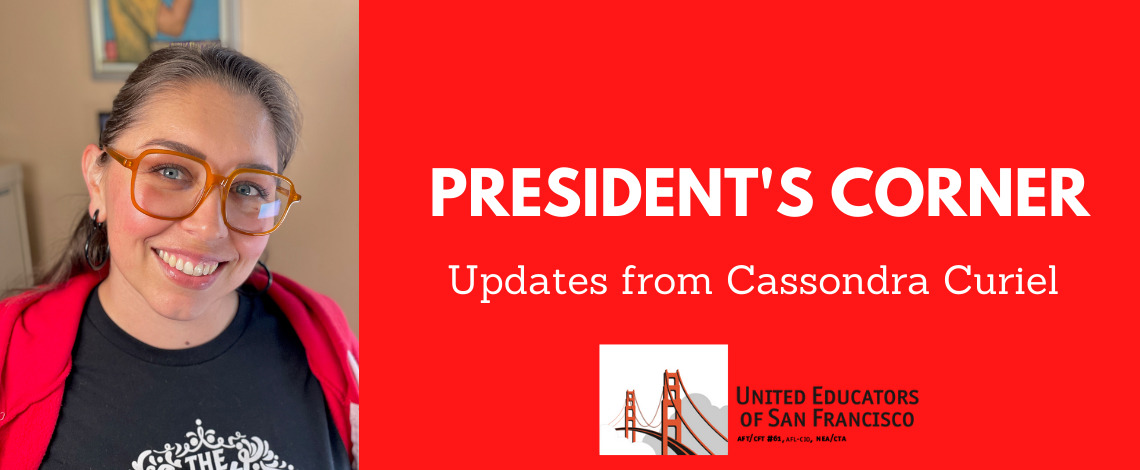
Earlier this month, the Editorial Board of The San Francisco Chronicle released an editorial titled “Californians are losing faith in public schools. They’re not wrong.” The disdainful attitude towards San Francisco Educators and our union in this piece mirrored that of many articles released by the Chronicle this past year. As an educator, I have felt that the Chronicle’s reporting has routinely cast us as adversaries of the students and families that we have worked so hard to support and advocate for when our local and federal government has so often failed them. This narrative around declining enrollment seems positioned to create division between educators and families, and distract from the inadequacies of elected officials who have refused to take appropriate action to protect our communities.
The Editorial Board refers to “years of relative stability in student population,” yet the California Department of Finance (DOF) anticipated a growing decline in enrollment across the state prior to the COVID-19 pandemic. Stemming from DOF projections, the Public Policy Institute of California (PPIC) released a comprehensive report in February 2020 detailing predictions of “a long period of declining enrollment” influenced by factors such as declining birth rates, migration patterns out of state, and increased charter school enrollment. While there is no denying that the COVID-19 pandemic has created a rapid and accelerated decline in enrollment, it is disingenuous to separate this change from these influencing factors which have only been exacerbated by the pandemic. It’s worth asking why the San Francisco Chronicle Editorial Board and political leaders are so invested in spinning these statewide enrollment changes in a manner that places the blame solely on public schools, educators, and our unions.
The Editorial Board alluded to a connection between the “exodus” unfolding at California public schools and San Francisco continuing “remote education months after private schools in the city and public schools in neighboring suburbs had reopened safely.” This seems to be a clear attempt to spin a narrative that parents have moved their children to private schools in response to alleged union “resistance” to reopening however, the Chronicle’s own reporting from January quoted Ron Reynolds, Executive Director of the California Association of Private School Organizations, as saying that the “state’s private schools have so far reported a cumulative enrollment decline of 6%, from 470,422 students to 441,678.” This willingness to ignore data that clearly shows a significant decline in enrollment at private schools in order to paint a falsely negative picture of public education is concerning.
In a separate article, the Chronicle suggested that enrollment has dropped as families “flee the district” while only briefly touching on the larger context of relocation from San Francisco. In early March the California Policy Lab released a policy brief that stated, “net exits from San Francisco from the end of March to the end of the year increased 649% as compared to the same period in 2019, from 5,200 net exits to 38,800.” Does the Chronicle truly believe that this unprecedented increase in movement from San Francisco has more to do with a reaction to educators’ commitment to ensuring a safe reopening than astronomical housing prices and historical job losses? This same study found that 80% of those exiting the City chose to remain in the State of California, where reopening plans have varied significantly making this connection between school’s reopening and declining enrollment questionable, at minimum. The PPIC’s data shows that while San Francisco County experienced a 3.9% decline in enrollment during the 2020–2021 school year, enrollment in Mono, Inyo, and Sierra counties fell by more than 8%. Despite partial reopening of all schools on March 16th, 2021, Marin County experienced a 4.7% decline in enrollment during the same school year.
While the Editorial Board was quick to point out that “California has reopened schools to fewer students than any other state on the mainland” in an attempt to connect these policies to declining enrollment, they neglect to discuss the status of enrollment in states that reopened schools sooner than California. Four states required in-person instruction at the start of the 2020–2021 school year: Florida, Arkansas, Iowa, and Texas. Arkansas and Iowa had an approximately 1% decline in enrollment by end of year. In Texas, enrollment dropped 3% between October 2019 and October 2020 while in Florida enrollment dropped 2.3%. Numerous states varying from Michigan (4.1%) to Kansas (3%) to Georgia (2.2%) experienced enrollment decline and many large urban centers like Boston (4.3%) and New York City (4%) were particularly impacted.
It is clear that this is not a challenge unique to California or to any one teachers’ union. Educators, students, and families everywhere have been doing their best amidst a global crisis, and declining enrollment is one of the innumerable ways the pandemic has impacted many people and therefore school districts across the country. Speaking to the Los Angeles Times, California’s Chief Deputy Superintendent of Public Instruction Stephanie Grisson said in reference to declining enrollment trends: “[t]here’s not one single answer why. This is very complex because every family has their own circumstances.” Declining enrollment in San Francisco, in California, and in the nation at large is clearly a complex phenomenon with many contributing factors. Reducing this complex issue to inflammatory talking points does not benefit students and families who are only harmed by divisive narratives seemingly intended to erode trust in educators.
As educators we know that public schools are the heart of our communities and how vital our unique position as a social safety net truly is. We have always remained unwavering in our commitment to providing a quality education while continuing to lead the fight for access to the resources needed to meet our students and families needs both in and out of the classroom. We also understand the importance of teaching our students to think critically about the information in front of them and formulate an informed response. Moving forward we invite everyone to join us in an honest conversation.
Classroom Teacher at Visitacion Valley Middle School and Newly Elected President of the United Educators of San Francisco, Cassondra Curiel



